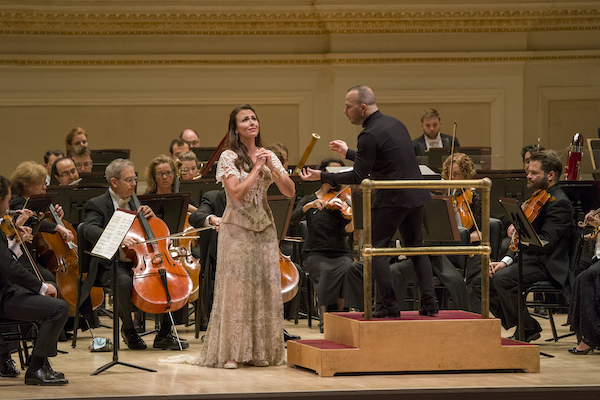Met Orchestra takes the spotlight in French program

Isabel Leonard performed with Yannick Nézet-Séguin and the Met Orchestra Monday night at Carnegie Hall. Photo: Richard Termine
The Met Orchestra turned the tables on its employer with the all-French program presented at Carnegie Hall Monday night.
The singers are the stars at the ensemble’s home base, the Metropolitan Opera, and one hopes the orchestra also does a good job. Monday at Carnegie, mezzo-soprano Isabel Leonard did a fine job indeed as soloist–but in the end, the orchestra was the evening’s principal component.
From the opening murmurs of Debussy’s La Mer to the orgiastic conclusion of Ravel’s Daphnis et Chloé Suite No. 2 two hours later, the Met players, under music director Yannick Nézet-Séguin, held the stage with a seemingly limitless color palette and an unerring sense of dramatic flow.
These two orchestral “standards” bookended a generous program that also included two concise song cycles: the almost equally familiar Shéhérazade of Ravel and the lively Le temps l’horloge (Time and Clock), the last finished work by the long-lived Henri Dutilleux (1916-2013) and a strong candidate for standard status in the future.
In any performance of La Mer, one looks for vivid nature imagery, and Monday’s performance had that in abundance. Debussy’s wizardry in mixing and contrasting orchestral colors was on full display, as every incident in the score had a texture all its own. Even the superb solos by wind players and concertmaster Benjamin Bowman came off not as star turns, but as threads of color in the big picture.
While attending to all these details, Nézet-Séguin painted the big picture over time as well. Debussy subtitled the piece “Three Symphonic Sketches,” and on Monday the symphonic ideal of a coherent statement spanning many episodes was realized through transparent textures, steady tempos and oceanic rhythms that had a physical presence.
As befits a nature piece with no people in the picture, Nézet-Séguin largely succeeded in rising above any sense of “performance” to create the illusion of wind, light, and water going their own way, without human intervention.
The human factor arrived in style with mezzo-soprano Leonard, fresh from her Met triumph (with Nézet-Séguin conducting) as Blanche de la Force in Dialogues des Carmélites.
She explored more nuanced and poetic territory in Dutilleux’s cycle. In the first song, also titled “Le temps l’horloge,” the singer’s refined tone was occasionally covered by the exuberantly ticking and bubbling orchestra, but later she warmed to the task and answered orchestral flashes with graceful leaps and melismas. In the second song, “Le masque,” Leonard brought a fluid line and polished tone to a dream vision of the poet confronting a huge, enigmatic mask in the sky. She muttered and occasionally soared through “Le dernier poème” (The Last Poem), as wheezing string chords and timpani going bump in the night evoked a bitter loneliness.
Following a brief orchestral Interlude, the concluding “Enivrez-vous” was a paean to liberating oneself from tedium and time, more gently playful than the title’s English translation (“Get Drunk”) would suggest. Leonard took her part’s curves and swerves with delicious abandon.
A different kind of abandon, that of abandoning oneself to fantasy, characterized “Asie,” the opening song of Shéhérazade, wherein every stanza begins “Je voudrais…” (I’d like to…). The imagined sights, sounds, and smells of Asia—where everything is more colorful, passionate, and violent than in the poet’s everyday life—evoked a rich variety of sound pictures from Ravel, vividly realized by Nézet-Séguin and the orchestra and described by the singer with loose-limbed phrasing and dreamy yearning.
And that was just one song. The remaining two made their points more simply. In “La flûte enchantée” a servant girl told of hearing her lover playing his flute in the street, and the mezzo-soprano shared the spotlight with a tender, insinuating solo by the orchestra’s principal flutist, Chelsea Knox.
A beautiful, androgynous youth sidled past the singer’s door in “L’indifférent,” ignoring her invitation to come in. It was hard to believe anyone could turn Leonard down, when she delivered her appeal in such a languorous parlando rubato, sensitively supported by Nézet-Séguin with cushioning strings or glowing woodwinds.
The conductor’s sense of sound chemistry remained strong right through the Daphnis et Chloé suite, beginning with the weightless flute zephyrs, piercing bird calls, and sensuous viola theme of the “Daybreak” scene. The “Pantomime” was daringly slow, yet lifted by the steady beat of pizzicato bass as its curling wind solos rose heavenward.
Although the last movement is titled simply “General Dance,” general frenzy would be more like it, especially in Monday’s propulsive yet fiercely controlled performance. One could imagine a Daphnis finale with a bigger, more muscular sound, but hardly one with more sheer motoric energy.
The Met Orchestra conducted by Yannick Nézet-Séguin will perform works by Mahler and Bruckner 8 p.m. June 14. carnegiehall.org; 212-247-7800.






